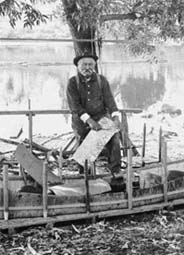Drawknife
A crooked knife is a one-handed drawknife form with a bent handle made from wood or antler. The knife’s blade is made by modifying a flat steel file, farrier’s knife, or straight razor to make a tanged blade with a cutting edge that is beveled on only one side. The blade’s tang is inserted into a wooden or antler handle and secured to the handle by sinew lashing, pitched string, wrapped wire or a metal sleeve. Handles are carved from a variety of hardwoods and antler and many are ornately decorated with carved designs ranging from playing card motifs to women’s legs.The knife is grasped fingers-up with the cutting edge held toward the user. Unlike knives used to whittle, the crooked knife is used to shape objects – sticks of brown ash for baskets, ax handles, canoe frames, and decoys – by slicing and shaving. Crooked knives are also used to hollow out wooden bowls and dishes.

Crooked knives were sometimes referred to as “canoe knives” and were an essential tool in canoe building.
